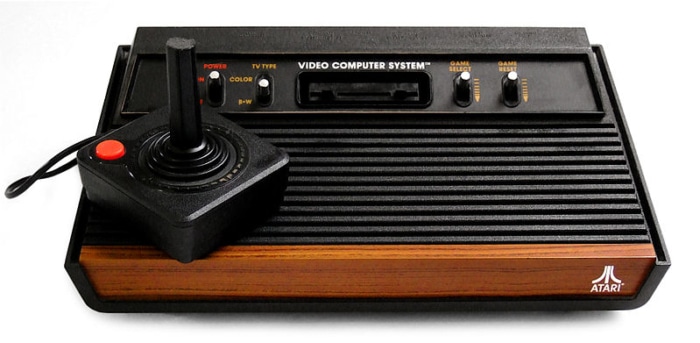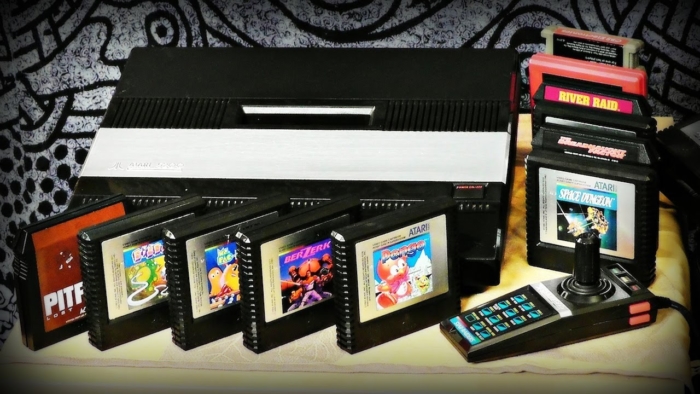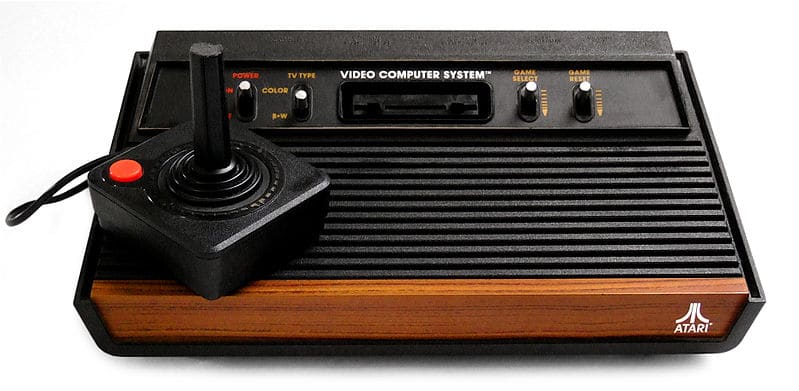The Atari VCS – Part One
There are some names in the games industry that can command a certain level of respect or, at the very least, some definite interest. It is with that in mind that the recent creation that has Atari’s name stamped on it generates an intriguing amount of attention. Not only have they written ‘Atari’ on the new console, but they are also calling it the ‘VCS’—The Video Computer System—harking back to the glory days of yesteryear. But is this system actually something worth looking at, or is it another strange entry to add to Atari’s checkered lifetime? At Ultimate Gaming Paradise, we are keen to look at the historical context of the new VCS, and how the lessons learned over the years might shine some light on this retro-styled console.
Join us, then, as we take a look back at Atari and their impact in the console world.
The Original Video Computer System
In 1977 the world, or at least North America, was given the Atari Video Computer System. It was the first successful cartridge console system.
The VCS came about as Atari saw a need to give players more of a range than the basic Pong machines that they had been putting out beforehand. While the excitement of two white bats bashing a single large-pixel ball from side to side might have been enough for those crazy cats of the mid-70s, players were starting to ask for more. After all, computer consoles could do more than just play one game, right?
Nolan Bushnell, Atari’s CEO at the time, was keen to make a system where the games could be switched in and out and thus sold separately. With the technology of the time, developing this idea proved to be really expensive, and although Atari had prototypes that could do what they wanted, the cost of production would have put buying the consoles out of the reach of the average American. Thankfully, at the same time, technology was being advanced and the MOS 6502 microprocessor came out, revolutionising the industry and making the VCS a viable idea. This impressive chip would go on to power many of the systems worldwide for the next few years, from the Apple II to the Commodore 64—importantly though, it made the Atari VCS possible. In the end, Atari used the cut down 6507 version of the processor; not quite as punchy, but cheaper and, when you are trying to market a new product to a new audience, the price was far more important than potentially better software in the long-term. As it was, the Atari VCS launched at $199 in 1977, which is equivalent to nearly $900 in 2021!

Bushnell was a no-messing type of businessman, the kind who didn’t see too many problems with bullishly pushing his competitors out of the way. In order to avoid other companies cloning the new machine and profiting from Atari’s hard work, he managed to convince MOS and other chip manufacturers not to sell to Atari’s direct rivals. A tactic that might be seen as dubious outside the most capitalist viewpoints.
Still, it worked. The only viable rival was the Fairchild Video Entertainment System, who had the advantage that they made their own chips (and thus weren’t affected by Bushnell’s back-door dealings) and came out first only to be beaten back by Atari, who took the market and the very first round of the console wars—thanks again to Bushnell’s business drive. A massive cash injection gained by selling Atari to Warner Communications helped them finish the console and, after release, put the VCS higher in the public’s eye to the extent that Fairchild limped away, even rebranding their system to the Channel F in order to avoid potential confusion.
As Christmas came about in 1977, the Atari VCS was the new toy that everyone in North America had to have.
The Games You Needed
Consoles can tout the best hardware in the world, but ultimately it is software that sells them. The Atari VCS was lucky in that it had that in the form of Space Invaders. Originally an arcade machine from 1978, Space Invaders was huge, becoming one of the very first games to enter the general zeitgeist and public consciousness. Everyone knew what Space Invaders was, irrelevant of their personal interest in the video gaming industry.
A strong port of the game to the home console market was going to be key, and this was exactly what Atari had in 1980. The VCS version of Space Invaders was considered definitive and boosted the consoles sold by more than double. It was the very first must-have video game.
The Atari Shuffle
Nolan Bushnell left Atari before Space Invaders made the console such a success, his enthusiastic expectation of sales not quite meeting reality towards the end of the 1970s. With Atari in the control of their owners, Warner Communications, Bushnell’s involvement was no longer required and away he went.
He wasn’t the only person to leave either in those years, with many of the team going off to form the software house Activision. By the time the VCS really started to dominate the market, the people that had made it happen were more or less all gone.
Was Atari even Atari anymore?
The VCS or a 2600?
In November 1982 the Video Computer System was rebranded as the Atari 2600 to unify the naming with their newer, upgraded Atari 5200 console. There were no changes made to the original VCS to become the 2600 (except to turn the console itself all black, losing the wood feature), whereas the 5200 was a whole different machine. This is where it starts to get confusing, but we’ll come back to this later.
The VCS in 2021 (Part 1)
As part of its marketing, the new VCS offers the ‘Atari VCS Vault’, a collection of one hundred original VCS games. It sounds great—a hundred games right off the bat?!—but what are we really talking about, here? Pong? Centipede? Space Invaders?

In 1980, these games were cutting edge. Skill-demanding, TV-controlling, addictive fun that sucked many hours of joyful hours from players, but the same can be said of a zoetrope or spinning top in the Victorian era. Are they actually worth looking at today?
Personally, I’m going to go with ‘no’. I love retro games and have a great fondness for many old games, but stretching right back to the dawn of console gaming and believing that the games offer anything more than a moment of curious interest comes across as slightly desperate. Sure, I’ll play Space Invaders for a few minutes for the nostalgia hit, but after the first game, I’ll put it down and look towards the huge pile of alternative, modern entertainment options I have.
Chances are high that the offerings of the Atari VCS Vault will, when combined, provide enough curio entertainment for a single evening and then never be looked at again. It all feels like those deals you got at the supermarket when DVD players were making a mark-you’d get a DVD player with 100 movies for £99.99, but the movies were mainly utter crap with one or two 25 years old blockbusters thrown in for legitimacy.
It’s one of the problems that immediately occurs with this new console offering—that we live now in a world of Playstation 5 and Xbox Series X, and where top-end PC games boast 4K resolution, 144FPS and all-immersive sound.
Where does a collection of forty-year-old games live in such a world?
Moving From Consoles to Home Computers
Once the VCS had been released, Atari worked on other projects, including the Atari 400 and 800 lines of 8-bit computer systems.
The personal computer boon was coming. While console systems were great fun, people were beginning to see that they could get more out of their hardware, and the lines between work computers, educational systems and gaming machines were beginning to blur. Like many other electronic companies at the time, Atari began to focus on this new market—home computers.
To some degree, they were successful. While neither the Atari 400 nor 800 managed to accomplish the sales of some of the more famous competitors, such as the Apple II, Commodore 64 or the British-born Sinclair ZX Spectrum, they did find a solid user base and can definitely be considered successes.
Unusually for home computers, both the 400 and 800 had cartridge slots for software, much like the VCS before them. Sadly, they weren’t directly compatible with the VCS (now 2600) games, although they did share a lot in common with the upgraded 5200 console and games were easily ported.
It’s All About the Joystick
Based on the Atari 400/800 and seen as a direct replacement and upgrade to the 2600, the Atari 5200 was released in November 1982…
…and died shortly afterwards.
The 5200 was technically superior to its little brother and was meant to be Atari’s answer to rival systems stealing its market share in the console market, specifically the ColecoVision and Intellivision machines.
Atari’s VCS joystick, the CX40, was a thing of wonder and beauty. With eight positions, it was a solid and beloved input device for controlling the games of the time, but it was only a matter of time before it was superseded. With their Intellivision, Mattel boasted the superior 16-position directional pad, and while such things may seem minor or even irrelevant by today’s standards, such technological improvements were enough to give Mattel an edge that was taking sales from Atari.
The 5200 came with a 360-degree analogue joystick which surely would blow the competition out of the water.
But no. Rather than make the 5200 a market leader, it was the joystick that sunk it. It was complicated mechanically, which meant it was easy to break and hard to fix, and the analogue controls simply didn’t work well with the digital and precise nature of the games. While modern games appreciate the high definition movement and subtleties of an analogue stick, the world simply wasn’t ready for it in 1982.
So, the 5200 died an early death. In the end, it lasted less than two years before being pulled in May 1984, and never found its way out of the North American market.
Maybe Atari’s luck was starting to wane.

The VCS in 2021 (Part 2)
The design of the new console owes a lot to the original. Purposefully, it looks like it could have walked right out of the 1970s, with a wood front on the ‘Black Walnut’ version that hasn’t been seen on a console since those early days—and it comes with that iconic joystick.
The New VCS’s classic joystick isn’t really the same as the original, of course. It has the same look as that CX40, but it’s a piece of modern technology that is analogue (thanks 5200), has rumble effects, subtle built-in lighting and (thankfully) no wires. Plus, there’s an extra button, because the original single-button joystick was a bit lacking.
It’s with touches like this that Atari is really able to interest and potentially capture the nostalgia market. Hell, I’d like to have one just for the joystick alone. This is retro done correctly; a 21st-century device that’s designed to hark back to the look and feel of a seventies living room icon.
Plus, it comes with a more standard modern controller if the joystick isn’t your thing.
The End of One Era, the Start of Another
Atari is nothing if not mutable. In 1983 came the great video game crash, and with it went Atari’s fortunes. A run of poor games that culminated in the infamously bad E.T. game combined with general market saturation and a shift from consoles to home computers marked their death. Turnover went from $2 billion to mere tens of millions and the company was done.
But like any great force, while Atari was down it was most certainly not out, at least, not quite yet. The Warner Communications version of the company was buried, and a new era began under the leadership of Jack Tramiel, the man who had started Commodore and was responsible for the VIC-20 and C64 machines.
Atari Inc. became Atari Corporation and the name lived on once more.
Next Time…
From ST to Jaguar… How does Atari fare in the late 80s and 90s, and what does it all mean for the VCS of 2021? Join us next time.

